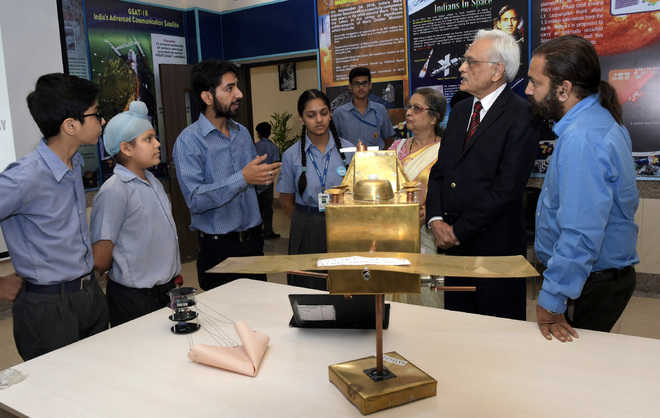Rashi Mathur
Tribune News Service
Chandigarh, October 27
Suresh Naik, former group director, Indian Space Research Organisation (ISRO), inaugurated Suresh Naik Centre for Excellence in Space Science at Dikshant Global School here today, enabling young boffins to get hands-on and practical training in space science.
The full-scale 'think and science lab' aims at helping students develop skills in telescope making, rocketry, sky gazing, designing, testing and launching satellites of the three main kinds— ‘CanSat’, ‘balloon’ and ‘cube satellites’.
Students developed a CanSat, a satellite integrated within the volume and shape of a soft drink today, the launch day of the lab. The prototype satellite could process data about the altitude, temperature, density and humidity of the surroundings.
“In future, students will develop balloon satellites to collect live data from an altitude of 1 km above the earth’s surface. In an advanced stage, the range will increase to 30 km of the stratosphere, which will be done in collaboration with ISRO,” said Mitul Dikshit, chairman, Dikshant Group of Schools.
In its endeavour to generate employment opportunities for students, ISRO has joined hands with multiple private firms to outsource satellite manufacturing. More than 400 private industries are assisting ISRO in rocket making.
Naik explained how this cost-effective strategy will benefit the organisation. “As many as eight satellite rocket launches take place every year, which will increase to 12 per year. With the help of private firms, the in-house rocket manufacturing of ISRO has been reduced to only 10 per cent. Rest of the production is handled by companies, which in turn recruit engineers to meet the demand. This way, ISRO can focus on research while the private sector is taking care of the manufacturing,” Naik said.
Alpha Design Technologies Pvt Ltd, Bengaluru, was the first private company to be chosen by ISRO. Other firms include, Godrej & Boyce, Centum Electronics and Hindustan Aeronautics.
Employment opportunities in the field of astronomy have increased tenfold according to Naik. “Students of the IUCAA, Pune, and Panjab University, Chandigarh, can even do research with the help of Astrosat, ISRO’s multi-wavelength space observatory, to discover new galaxies, planets and stars. So far, students had to travel to the US and Russia for research. However, now the scope for research and employment has increased in India.”
ISRO’s roadmap
By the end of March 2018, ISRO will launch two major space exploration projects— Chandrayaan-II and Mangalyaan-II. “Chandrayaan-I did not have a smooth landing. Chandrayaan II involves the use of a rover to ensure a soft landing. New technology comprises a robotic arm that will help dig soil, take samples and send them for analysis to the Bengaluru earth station,” explained Naik. Mangalyan-II is ISRO’s second interplanetary mission planned for launch to Mars.
Unlock Exclusive Insights with The Tribune Premium
Take your experience further with Premium access.
Thought-provoking Opinions, Expert Analysis, In-depth Insights and other Member Only Benefits
Already a Member? Sign In Now










